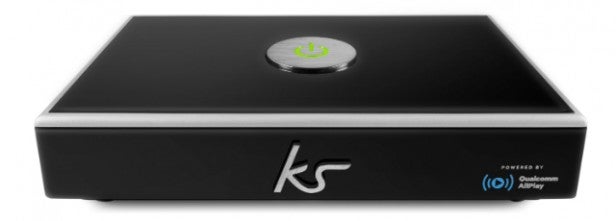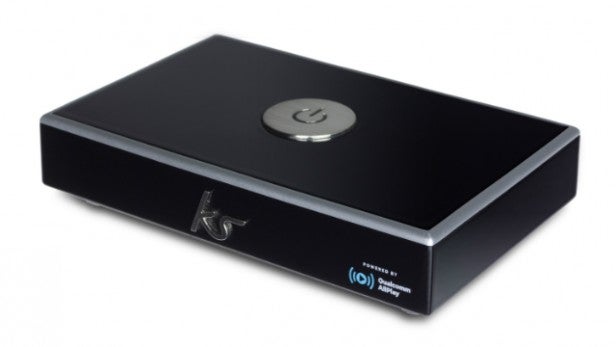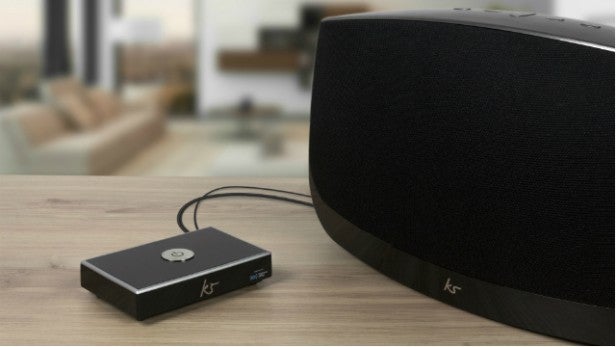KitSound Link Review
KitSound Link
Save money on multiroom speakers with KitSound’s clever adapter

Verdict
Pros
- Attractive price
- Turns old audio systems into multiroom speakers
- Flexible, easy-to-use app
Cons
- Plasticky build
- Missing music services
Key Specifications
- Review Price: £70.00
- 5GHz Wi-Fi connection
- Qualcomm AllPlay Jukebox app
- DLNA, AllJoyn, Spotify Connect support
- High-resolution audio playback up to 192kHz/24-bit
- Multiroom streaming (up to 10 devices)
What is the KitSound Link?
KitSound Link is one to file under “great idea”. It’s a multiroom audio adapter that links any speaker to your wireless home network, allowing you to incorporate audio systems of any vintage into a multiroom setup. All that’s required is a 3.5mm mini-jack input.
KitSound’s system is controlled by a free smartphone app, which sends music from DLNA devices and streaming services such as Spotify to any room in the house. It works in the same way as multiroom products such as the Samsung R7 and Sony SRS-X88, except that you don’t need to fork out for an expensive new speaker – just spend £70 on this gizmo and give your existing audio systems a new lease of life.

KitSound Link – Design and Connections
The Link itself is a small box measuring 119mm wide by 27mm high, making it compact enough to perch on top of other components or place on a desktop. The gloss black finish is a real fingerprint magnet but rather stylish, enhanced further by a thick silver trim around the top panel.
The brushed-silver power button on top features an illuminated standby icon that glows in different colours to denote the unit’s status. The only other visible clutter is the KitSound and Qualcomm AllPlay logos on the front.
Build quality is good but not great – it’s light as a feather, the buttons click loudly when pressed and the plastic casing feels, well, plasticky. At this price, however, it’s difficult to complain.
On the back you’ll find optical digital and 3.5mm analogue outputs, plus buttons for WiFi and Direct mode setup. The Link is powered via the micro-USB port – you can connect a 5V DC power adapter (not supplied) or hook it up to your sound system’s USB port using the supplied USB-to-micro USB cable.
KitSound Link – Features
KitSound Link uses Qualcomm’s AllPlay platform, and will therefore work with any other compatible speaker or device. The app is available for free from the Google Play or Apple Store, and allows you to stream music from a variety of online services – or plunder the music libraries on your PCs and NAS drives (DLNA and AllJoyn are supported).
The system supports MP3, AAC, AAC+, FLAC, ALAC, WAV and PCM playback, with high-resolution audio playback up to 192kHz/24-bit.
The AllPlay app provides access to Spotify, doubleTwist, SomaFM radio player, AllPlay Radio (powered by TuneIn), Napster, Aupeo, DAR.fm, Astro Player and Rhapsody (which isn’t available in the UK). A few more services such as Deezer or Qobuz wouldn’t have gone amiss; Qualcomm says Tidal and SoundCloud are coming soon.
Flexible multiroom functionality lets you stream the same song to multiple rooms (up to 10), or play different songs on different speakers. The Link uses a 5GHz WiFi connection for use with compatible routers (which KitSound recommends when playing high-resolution audio).
KitSound Link – Setup
Installation is relatively hassle-free. To connect the KitSound Link to a WiFi router, wait until you see a flashing white light then press the WLAN button on the back and the router’s WPS button at the same time. A solid white light tells you the unit is connected. Admittedly, it took a couple of attempts to make it work, but that’s par for the course in the world of wireless audio.
If your router doesn’t support WPS, you can connect your phone directly to the Link and enter login details on your phone’s browser. In fact, you don’t have to use your router at all – Direct Mode lets you stream music to the Link over a peer-to-peer WiFi connection.
Once connected, launch the AllPlay Jukebox app and its helpful onscreen instructions guide you through the setup process. It searches for AllPlay devices on the network and adds them automatically. Connected Links are listed on the first page, and to add new ones just tap the “+” icon at the top of the page and repeat the process above.
To create a multiroom system, you’ll need a KitSound Link for each speaker you want to add, but at £70 a pop it’s much cheaper than buying new speakers. You can rename each speaker to make them easier to identify.
Multiple Links can be grouped together in “Party Mode”, which plays music on all speakers simultaneously. Grouping them is easy – just tap the checkboxes next to the devices you want to include. You can make the group operate as a single speaker, using the slider to adjust the universal volume, or you can tweak the volume of individual speakers.
KitSound Link – AllPlay Jukebox App
The app is thoughtfully designed and easy to use. Presentation is crisp and colourful without being too clever; it sticks with straightforward lists and large, stylised icons. The Music menu offers four options – Device (the phone you’re using), Network (DLNA devices), Music Services (Spotify, and so on) and Settings.
Select Services and you’ll see the full list of streaming sites. Tap one and it takes you to the relevant app on your phone – if it’s not installed, you’re whisked off to the Google Play or App Store.
Elsewhere, it’s easy to navigate through music libraries on a phone or connected DLNA device. The attractive “Now Playing” screen displays all the key information in a clear, uncluttered manner, including cover art, track timeline, volume level, transport controls and repeat/shuffle functions.
Any tracks you play are added to a queue, which can be displayed by tapping the “list” icon at the top of the screen. When you select a track, a dialog box asks where you want to place it in the queue. Cleverly, other people can even use their smartphones to add tracks to the playlist.
KitSound Link – Performance
Overall, I had no major problems setting up and controlling multiple speakers in KitSound’s multiroom system. It’s as slick and user-friendly as any other multiroom system I’ve tested, and the only drop-outs or glitches I experienced were caused by the phone losing its WiFi connection, not by the Link itself.
Naturally the calibre of your audio system determines sound quality, and a 3.5mm mini-jack lead would hardly be an audiophile’s conduit of choice, but KitSound Link transfers the music without any signs of degradation.
I played a range of tunes on a few speakers around the house – including a small Roth bedside Bluetooth speaker, a three-year old Samsung DA-E750 docking system and pair of Onkyo-driven Monitor Audio Gold speakers – and sound quality was impressive through all of them.
Hi-res tracks such as David Benoit’s “Barcelona Nights” streamed from an Android smartphone positively sparkle with sonic detail and rich dynamics, while lower-quality Spotify streams sound lively and well balanced.

Should I buy the KitSound Link?
If you’ve been jealously admiring the latest generation of wireless multiroom streaming speakers, wishing your trusty old sound system did the same thing, then wish no more. KitSound’s clever wireless device turns any speaker to a multiroom device and does so with the slickness and flexibility of a more expensive setup. The beauty is that you’re not tied into any one brand as you are with most multiroom systems.
Qualcomm’s attractive AllPlay Jukebox app makes it easy to access DLNA devices and streaming services. There are no complaints about sound quality and the unit’s compact dimensions make it easy to accommodate.
On the downside, build quality could be better and a few more streaming services would be nice. On the whole, however, the KitSound Link is the ideal solution for anyone who can’t afford to start a new multiroom system from scratch.
Verdict
KitSound’s clever wireless adapter is a cheap and easy route into multiroom audio with its flexible streaming functionality, superb app and solid sound quality – although more music services would be nice
Trusted Score
Score in detail
-
Design 7
-
Sound Quality 8
-
Features 7
-
Value 9
-
Usability 8
Audio Codecs
| MP3 | Yes |
| Apple Lossless | Yes |
| AIFF | No |
| AAX | Yes |
| WAV | Yes |
| AAC | Yes |
Physical Specifications
| Weight (Gram) | 299g |

